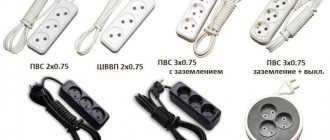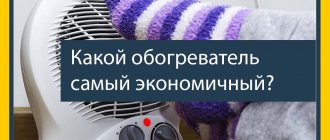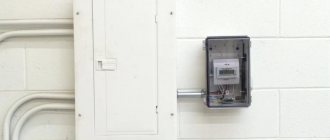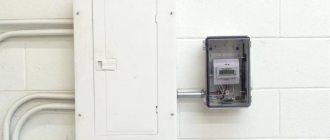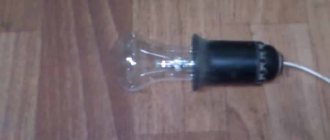On the modern heating equipment market you can find a wide range of equipment. Let's look at what a convector type heater is. Let's get acquainted with the features of radiators regarding connection, heat source and connection features. Read to the end and you will learn about the criteria that need to be taken into account before making a final decision to make your home comfortable and safe.
Floor convection heater Source bricomarche.pl
General description of the equipment
Radiators are a group of technical devices that are designed for primary or additional heating of a room due to effective heat transfer. The source can be a water circuit, liquefied or natural gas and the electrical network. Let's look at what a convection heater is and how it works.
Traditional units made of cast iron or with coolant oil release thermal energy through the housing. The walls can heat up to +95 degrees Celsius, which is unsafe for the user. The solution to this problem was the manufacture of radiators with perforations on top and slots on the bottom. This way the housing is cooled due to relatively cold air flows in the area. According to the laws of physics, they displace the warm environment that spreads throughout the room. The operating principle of a convector heater is based on this phenomenon.
Equipment is divided into 3 groups according to the type of heat source. Water ones are connected to a central or autonomous water supply and are a lighter and more aesthetic alternative to cast iron “accordions”. Electric works from the network. Here, heat transfer occurs due to the built-in heating element.
Electric radiator of convector type Source vodopad.ru
It is believed that the efficiency of this series of equipment is 100%.
Gas convectors are an economical and practical solution. But the installation is carried out taking into account the permanent installation, stretching of the pipeline, and arrangement of an outlet channel for fuel combustion products. Design and repair difficulties, final estimates for materials and specialist work, maintenance are the reasons for the low demand for equipment.
Simple models can be improved by connecting thermostats. Instead of slots and perforations, adjustable dampers – blinds – can be installed. Another solution is to cast the cracks not in a horizontal position, but with a slope towards the floor. Let's get acquainted with the device and criteria for choosing a convector heater for your home.
Types and features of thermostats
The thermostat, which can be mechanically or electronically controlled, is responsible for maintaining the desired temperature in the room in the convector design. A mechanical thermostat reduces the cost of the design, but at the same time introduces some inconveniences into the process of using the device, in particular:
- does not withstand temperature conditions well
- consumes more electricity
- accompanies its operation with characteristic clicks when turning it on and off, which can be a very annoying factor
An electronic thermostat significantly outperforms a mechanical one; it:
- completely silent
- maintains a given temperature value with a minimum error of one tenth of a degree
- Reduces energy consumption to the extent possible
- makes it possible to carry out “climate control” remotely
- supports several operating modes - “comfort”, “economy”, “automatic”, “anti-freeze”.
Convectors with an electronic thermostat are more expensive than models with a mechanical one - but they are definitely worth it.
Electric convector with electronic thermostat
The presence of a thermostat and heating element switches allows you to regulate the air heating temperature in fairly wide ranges.
Radiator design
When choosing convector-type heating equipment, you need to consider the intended heat source. Depending on this, the design of the units differs, which is reflected in the requirements for installation work. Let's take a closer look at each series.
Gas
A sealed closed chamber and a burner are built into the body of such equipment.
Gas type convection radiator with a closed chamber Source kotlotorg.ru
Oxygen access is ensured in the section where fuel combustion occurs. To do this, a relatively wide channel with a windproof lining in the form of a lattice is brought outside. There is also a pipe for connecting the outlet of combustion products of gas fuel to the outside of the building. It is inserted inside the supply pipe. Such a system is otherwise called coaxial.
There are models with an open gas combustion compartment. This is a positive introduction regarding the decorative component. However, in this case, partial air intake occurs and it is saturated with carbon dioxide inside the heated room.
When choosing a unit, it is necessary to take into account the type of combustible fuel:
- natural gas - according to GOST it must meet low pressure (1274 MPa);
- liquefied - a gearbox and a nozzle are provided for connection, and a control unit is provided for adjustment.
When considering samples for long-term use, you should prefer radiators with a chamber cast from cast iron. It retains heat longer and only cracks due to sudden cooling or heating. This is also justified by the fact that even heat-resistant steel burns out over time. On the other hand, equipment with steel compartments weighs 10-15 kg less.
Model of a gas convector with a cast iron chamber Source 35.teplozhar.ru
The heat exchanger is typically designed in area to operate at temperatures ranging from +60 to +120 degrees Celsius. Heating occurs quickly and evenly. Actual heating can reach +600 degrees, but in household models this is excluded.
Before making a decision, you need to familiarize yourself with some features of the heater:
- high heating of the heat exchanger provokes the disintegration of dust particles, so regular ventilation of the heated room is necessary;
- there is a noticeable temperature difference in the area of the equipment and at a distance from it;
- to ensure the flow of oxygen and the removal of gas combustion products, access to the street is required, which forces the owner to form a through hole in the wall;
- if the supporting structure is made of flammable material, then additional insulation of the channel with a fire-resistant sealant will be required;
- It is recommended to install a coaxial pipe in the area of the window opening for better ventilation (the distance from the slope is kept at least 30 cm, from the floor - more than 15 cm);
Traditional radiator location Source mr-build.ru
- the gas pipeline system is laid in strict accordance with fire safety requirements;
- Before starting heating equipment, an assessment by a specialist is required to ensure the correctness and serviceability of the system (in the case of a central gas supply, permission to connect a radiator is also required).
The advantages of a gas heater include efficiency. This applies to the cost of the power supply. Also, a pair of convectors is cheaper than installing a boiler with the same fuel. Warming up the room is done quickly, since heat transfer from the combustion chamber begins almost immediately.
See also: Catalog of companies that specialize in home insulation
Water
Structurally, the convector for heating is represented by a copper pipe for the coolant and aluminum fins made of plates as a heat exchanger. For connection to a central or autonomous water supply system, pipes with threaded fittings are provided. To prevent air accumulation in the radiator, there is an air valve.
Convection radiator in water coolant Source mircli.ru
The housing is often made of thin sheet steel that is resistant to temperature changes. Powder paint is applied to the front side of the back panel by spraying. To ensure convection, there are slots at the bottom or there is no platform at all; there is perforation in the top cover.
Before making a decision, it is worth considering the following features of the operation of a water convector:
- copper and aluminum conduct heat well, so the heat exchanger heats up and cools down equally quickly (this affects the overall environment in the room);
- For efficiency, heating equipment is often made in a relatively larger size than conventional radiators;
- the heat exchanger is represented by many plates, on which a lot of dust, dirt and animal hair settles, which must be constantly removed (it is not recommended to install such a radiator in a house with allergies).
The advantages of a water convector heater for the home are enough to be in great demand in the private sector. This equipment is permissible for installation in an apartment, house or country house without obtaining official permission. Unlike traditional radiators, efficiency is observed here even at low coolant temperatures. The total weight of the unit is low due to the lightness of copper, aluminum and steel. Weight is largely influenced by the volume of coolant. But in most cases, mounted radiators can be mounted on plasterboard walls.
Electric
The main difference between an electric convector heating system and its analogues is the absence of a sealed fuel combustion chamber or pipeline. Here, a compact heating element is located inside the hollow body. It converts electric current into thermal energy.
Electric convector design Source termo-volga.ru
Based on this, the main advantages of the convector are:
- instant air heating;
- low weight of the structure;
- there is no channel system for coolant, oxygen or smoke exhaust.
The narrow box has the following features:
- Material. Aluminum or thin sheet steel is used to make the body. Corrosion protection is provided on the inside, and powder paint is additionally applied on the outside.
- Top and bottom end. There are slots, perforations or blinds. The last option can be adjustable.
- Back wall. There are plates soldered on it for hanging the radiator on response brackets or hooks.
To figure out which electric heating convectors are best for a private home, you need to consider the features of built-in heating elements. The table shows the characteristics of each of the possible heating elements.
| Heating element type | Description | Technical features |
| Stitch | In Russia the accepted name is needle-shaped. Consists of a dielectric plate and an incandescent filament. The conductive element is made of a nickel-chromium alloy and has an insulating coating with heat-resistant varnish. This ensures the core is protected from direct contact with oxygen. The wire is attached to the base in the form of many loops on both sides. | The tape is heated within a few seconds to +250 degrees Celsius. It takes the same amount of time to cool down. The radiator operates silently. Consumes relatively little energy. |
| Tubular | The element is made in the shape of a flask. Material: high-strength steel. The cavity is filled with quartz, ceramic or magnesium sand of fine fraction. In order to increase efficiency, aluminum plate or spiral elements are attached to the flask. The technical design of fins varies among manufacturers, but the heat transfer is almost identical. The heat source is a filament built into the flask. | Since the filament is isolated from oxygen, its service life is extended by 1.5-2 times (against the background of a needle heating element). The degree of protection of the heating element can be equal to IP24, which allows you to install the radiator in a damp room, but away from splashes (0.6-1 m). Full heat transfer begins after a few minutes. |
| Monolithic | This is a one-piece design with a filament inside. Here the sealed flask is made of silumin alloy (based on aluminum and silicon). The filler is often quartz sand. The fins here are fixed on four sides and have an X-shape. | It is considered the most effective and protected from moisture. Heat loss is minimized due to tightness and fins. It does not affect the state of the surrounding air. Expensive, but can be used in almost any room. |
Household-type heating elements are characterized by power from 0.3 to 6 kW. To replace the heating element, pay attention to its length. It is recommended to consider a size 10 cm smaller than the heater body. Also, the passport must contain a list of radiators for which one or another heating element is applicable.
Heater temperature regulator
The choice of a specific model depends on your preferences, conditions in the house, type of heating and financial capabilities. Only this saving is insignificant compared to the thermal losses of the building, which any heater must compensate for.
And it is able to maintain the desired temperature in the house without additional intervention. You can regulate the heat supply to radiators using built-in thermostats. They produce both plain panels and those decorated with photo printing. Ceramic heaters are produced in three versions. The optimal thickness of the anodized layer is 0.mm, and the foil 0.mm.
Some people use differential protection devices here. Any copyright infringement will result in legal liability.
The difference is that they are connected through an outlet and have a control unit, and sometimes a remote control. Installing an electric cooling radiator fan on a VAZ 2106 (classic)
Equipment selection criteria
To determine which convector is best installed in a particular room (electric, water, gas), you need to consider the operating conditions and installation of the radiator. The power and dimensions of the equipment are also taken into account. Let's consider the selection criteria in more detail.
Installation
There are two main types of radiators: stationary and mobile. The first ones are installed in the designed position without the possibility of movement. These are all water and gas radiators, some electric. This group includes heaters for hanging, built into walls or floors. Equipment with a network connection can be classified as mobile; the main thing is to place the cable safely.
Mobile model of a heating convector Source ventoprofi.ru
Video description
In this video, the master talks about the difficulties and problems that can be encountered when installing a water convector with water heating:
terms of Use
For dry rooms, you can choose any convector heater. For a kitchen or bathroom, it is necessary to consider the degree of protection of the heating element and control unit in the case of electrical equipment. In addition, it is necessary to take into account the heating temperature of the housing in order to prevent the occurrence of burns or fire of surrounding objects and decorative trim.
The second point can be eliminated using devices that are equipped with an automatic overheating sensor. It turns the equipment off and on when the set temperature thresholds are reached. Another solution is to install a thermostat. This device allows you to independently adjust the heat output of a convection heater.
Convector with thermostat Source elektro-teh.com
Power and efficiency
For a temperate climate in Soviet times, calculations were made. As a result, even today it is believed that 1 kW of energy must be taken into account per 10 square meters of area. It is worth noting that such a guideline is relevant for a house in which there is practically no heat loss; the ceiling height is limited to 2.7 meters. That is, for constant convector heating of dilapidated housing or with high ceilings, you need to increase the power. The additional heat source can be selected with a lower value relative to the reference.
The efficiency of radiators depends not only on the design of the basic components and its power. Additionally, the unit can be equipped with a fan. It provides forced movement of heated air, which speeds up the process of warming the space in the room.
Advantages of convectors
Electric convectors are functional heating devices designed to provide a comfortable room temperature. The devices are characterized by many positive features:
- simple operation and safe operation;
- easy installation;
- multi-year warranty from manufacturers;
- long service life (up to 30 years);
- no need to perform complex and specific maintenance;
- affordable price;
- a wide range of models with different technical parameters;
- reliable automation and electronics operating in automatic mode;
- quiet operation without creating extraneous noise;
- economical and high performance.
There will be no difficulties when installing convectors. They are easily mounted to the wall in the right place. The devices can also be placed on special legs. After connecting to a power outlet, the device is ready for full operation. Many models have a manufacturer's warranty of up to 10 years.
Caring for devices involves periodically cleaning the housing from dust and dirt. Thanks to a large selection of convectors, each buyer will be able to choose a model for themselves, taking into account their budget, functions and technical characteristics.
You can ask questions about the operational features of electronic convectors and receive qualified assistance in choosing heating devices by phone or by sending an electronic request. Our specialist will contact you shortly to clarify all questions.
The main requirement for operation
The principle of operation of a convector for heating a private house or apartment is the passage of air flow through the equipment body. This phenomenon eliminates the possibility of covering the radiator with anything for the purpose of warming or drying. If you block the perforations or slots in the upper end of the box, the heated air will not be able to spread with proper efficiency. In the case of a convector-type electric heater, humidity can be a detrimental factor for the heating element or a person. This is justified by the fact that water is an excellent conductor of current.
